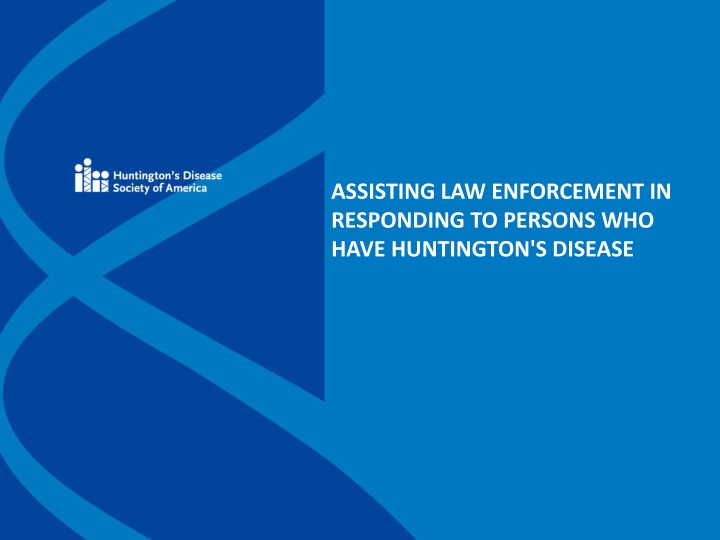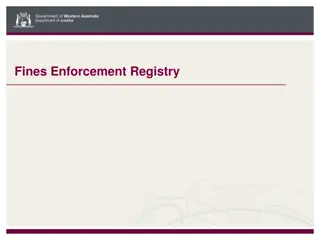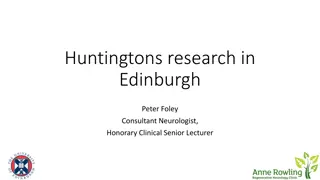Assisting Law Enforcement in Responding to Huntington's Disease
Huntington's Disease (HD) is a progressive neurologic disorder affecting behavior, movement, and cognition. Individuals with HD face challenges as symptoms worsen over time, impacting their independence and quality of life. Recognizing behaviors like staggering gait and abrupt movements is crucial for law enforcement in responding to situations involving individuals with HD. Learn more about the defining characteristics and symptoms of HD to better understand and support affected individuals.
Download Presentation

Please find below an Image/Link to download the presentation.
The content on the website is provided AS IS for your information and personal use only. It may not be sold, licensed, or shared on other websites without obtaining consent from the author.If you encounter any issues during the download, it is possible that the publisher has removed the file from their server.
You are allowed to download the files provided on this website for personal or commercial use, subject to the condition that they are used lawfully. All files are the property of their respective owners.
The content on the website is provided AS IS for your information and personal use only. It may not be sold, licensed, or shared on other websites without obtaining consent from the author.
E N D
Presentation Transcript
ASSISTING LAW ENFORCEMENT IN RESPONDING TO PERSONS WHO HAVE HUNTINGTON'S DISEASE
Acknowledgements HDSA Workgroup Robert Barron Jayne Brown, LCSW Stephen Clingerman, PhD Barbara Heiman, LISW Bruce Jennings, MA Eileen Krueger, LCSW Lynn Ross, LMSW Gerleine Schoonover Jane Kogan, LMSW Seth J. Meyer, LMSW Karen Tarapata, Editor Advisors Lieutenant Chris Bowling Police Chief David Bloomer Tom McCarrier, EMT-I Officer Heidi Miller Arik Johnson, PsyD Kathleen M. Shannon, MD Special Thanks to the HDSA Center of Excellence at the University of Rochester and Amy Chesire, LCSW-R, MSG for providing video clips for the presentation Developed with funding from a generous grant from the Griffin Foundation
Contents An overview of Huntington s disease (HD) Defining characteristics Behaviors that may be symptoms of HD Situations that involve law enforcement Understanding HD: The Triad of Symptoms Vignettes Take Home Points
An Overview of Huntingtons Disease (HD) HD is a progressive disorder caused by the death of neurons in the brain, with a steadily worsening course, so patients and families have challenges that change over time. HD affects three primary aspects of normal function: Behavior (Psychiatric Functioning) Movement (Motor Functioning) Thinking (Cognitive Functioning) Symptoms typically begin between the ages of 30 to 50 and progressively worsen until the affected individual is unable to live independently. Presently, there is no cure, although medication can relieve some symptoms in certain individuals. According to current estimates, approximately 30,000 people in the U.S. have HD and more than 200,000 others have a 50% chance of inheriting the disorder from their affected parent.
The brain on top is that of a patient who had HD. The brain on the bottom is a normal brain. Note that the holes in the center of the brain on the top are larger. This is due to death of brain cells. The overall brain size is also smaller in HD, also due to cell death.
Defining Characteristics Progressive and degenerative over many years. Purely neurologic disorder (only affects the brain). Adult-onset in approximately 95% of all cases. Genetically inherited disease. Characterized by the Triad of Symptoms: a behavioral disorder, a movement disorder, and a cognitive disorder. Fatal.
Behaviors that May be Symptoms of HD Staggering gait. Jerking or abrupt movements of the face, trunk or limbs. Slurred speech. Speech too loud or soft, fast or slow. Inability to answer questions quickly. Disorientation or lack of attention. Irritability or combativeness. Impulsive behavior, such as shoplifting. Sexually inappropriate behavior, such as public masturbation and inappropriate touching of strangers. Explosive temper or emotional outbursts. Driving erratically or too slow.
Situations that May Involve Law Enforcement Aggressive behavior. Domestic violence. Disappearance/Missing person. Suicide attempts. Behavior that mimics drug or alcohol intoxication. Erratic driving/Inappropriate speed. Inappropriate sexual behavior/Sexual abuse. Actual drug or alcohol intoxication. Shoplifting. Inappropriate Smoking.
Understanding HD: The Triad of Symptoms Cognition Motor Psychiatric
Psychiatric/Behavior Issues Psychiatric/Behavioral Symptoms Law enforcement concerns Anxiety/Irritability/Agitation Inability to calm down, listen and respond to officers. Impulsive behavior and poor judgment Reckless or dangerous behavior; shoplifting; inappropriate sexual behavior or abuse. Emotional outbursts/Aggression Rapidly escalating anger or violent reactions. Shouting or fighting possible. Inability to switch focus and respond to officers. Fixed ideas/Compulsive behavior Apathy Limited response can be mistaken as willful resistance. Clinical depression - sadness, guilt or suicidal thoughts Heightened possibility of self-harm. May require evaluation or hospitalization. Bipolar mood swings, possible paranoia; rare hallucinations Behavior not under individual s control. May require evaluation or hospitalization.
Suicide Suicide is three times higher in people with HD than in the general population due to a combination of depression and lack of inhibition, both of which are symptoms of HD. Any expression of sucidality should be taken seriously with appropriate interventions. People with HD should be assessed for suicide risk. If detained, consider suicide watch for the incarcerated individuals with HD
Strategies for Law Enforcement In addition to strategies generally used to address psychiatric issues, consider using the following: Due to the disease, people with HD may not be able to think things through enough to realize the consequences for their actions. Inform the person with HD the consequences of inappropriate behavior without doing so with threats or anger. The brain damage caused by HD makes it difficult for people to process information. Allow extra time for the person to comprehend. Use simple yes or no questions. This can help stop a person with HD from getting frustrated and reacting aggressively. Sometimes helping the person acquire what they are requesting will help de-escalate the situation.
Strategies for Law Enforcement In addition to strategies generally used to address psychiatric issues, consider using the following: Consider other causes of discomfort: fear, hunger, fatigue, dehydration, medication effects, or substance abuse. Consider the need for a hospital evaluation. Acknowledge feelings and actions, then try to redirect. A loved one may provide helpful strategies and a source of support. Pay attention to suicidal thoughts or gestures; ask the person with HD if s/he is suicidal.
Motor (Movement) Disorder Symptoms of the motor disorder Law enforcement concerns Difficulty walking a straight line, knee dipping Mimics intoxication. Balance problems Mimics intoxication. Involuntary jerking or twitching movements Mimics intoxication/willful resistance. Slowing of movements Inability to respond quickly to requests/commands. Difficultly speaking, chewing and eating Danger of choking while in custody/Difficulty responding to requests or commands.
Strategies for Law Enforcement In addition to strategies generally used to address movement issues, consider using the following: Avoid restraints, if possible, as they may be dangerous for a person with HD who has involuntary movements. If restraints must be used, the person must be checked frequently for abrasions, entanglement, or other restraint-related injury. Keep the person calm, as stress can sometimes make a person s movement disorder worse. Ask the person to take a breath, slow down, and repeat the statement. If the person with HD is detained: Be alert for choking, especially when the person is eating or drinking. If the person is with a caregiver, ask about any problems eating and swallowing. A person with HD burns calories at a faster rate. Incarcerated people with HD may need larger food portions. Those in long-term incarceration should be weighed monthly, and weight loss reported to medical staff.
Cognitive Issues Cognitive Symptoms Law enforcement concerns Problems with multi-tasking, attention and concentration Slowed ability to answer questions Inability to follow multi-part directions. Apparent disorientation. Impulsive behavior and poor judgment Difficulty with sense of time Irritability Reckless or dangerous behavior; shoplifting; inappropriate sexual behavior or abuse. Repeated requests for the same thing. Inability to calm down, listen and respond to officers. Emotional outbursts Difficulties with short term memory/new learning Fixed ideas/Compulsive behavior Emotions not under the person s control. Difficulty retrieving information/ answering questions. Inability to switch focus and respond.
Strategies for Law Enforcement In addition to strategies generally used to address cognitive issues, consider using the following: Allow more time for responses, either verbal or physical. A 10 second gap between questions and response is not unusual for people with HD. Be aware of loss of focus and concentration . Ask simple questions; multiple choice or yes or no questions are better than open- ended: Are you sick?, rather than What s wrong with you? or Do you live on this street?, rather than Where do you live? People with HD may have difficulty responding to questions with too many options or with options that are too vague.
Strategies for Law Enforcement In addition to strategies generally used to address cognitive issues, consider using the following: Be patient: allow extra time; ask the person to repeat or speak more slowly. Remember the person may be forgetful. Explain limits and rules concisely in a firm, respectful tone. It is important to give information in short statements and phrases too much information can overwhelm the person with HD. Give the individual your full attention. Don t just listen to what they are saying, but reflect back what the person is saying to clarify statements.
Vignette: Movement Issues with HD Middle-aged woman with mild to moderate HD has plans to see a play with her friend in a large city. She is observed waiting in line with slurred speech, unsteady gait, and arms waving at times. Although the woman is sober, attendants at the theatre call law enforcement, assuming she is intoxicated. Officers arrive and the woman becomes angry and raises her voice, denying that she has been drinking. She is arrested with the charge of public intoxication and disorderly conduct .
Vignette: Psychiatric Issues with HD A woman in her 40s with moderate HD dials 911 accusing her husband of aggressive and abusive behavior. Police officers arrive and husband denies being violent or abusive He states he was trying to help her and reports that she has HD. Officers determine the woman is paranoid and acutely agitated. After talking things out, the woman with HD and the caregiver are calm and cooperative with each other. No arrests made and neither taken to the hospital.
Vignette: Cognitive Issues with HD A man with HD in his 40s has a prescription for a controlled stimulant medication. When the physician cannot be reached by phone, the prescription is rejected. The person with HD becomes agitated and refuses to leave the pharmacy window. Law enforcement is called and a struggle ensues. When the physician is contacted, confirming the prescription, he is eventually released without charge.
Vignette: Cognitive Issues with HD Young adult male in his early 30s with moderate HD has been incarcerated for assault and placed in the general population. Other prisoners make fun of him because he repeatedly forgets when meal, exercise, and shower times are and does not show up for his work program. Angered by the taunts, he continues to be involved in a number of fights with other prisoners in the general population and has repeated run-ins with the guards. He does not earn early release and has had an increased sentence for his impulsive actions and aggressive behaviors.
Take Home Points Huntington s disease is a brain disease that leads to brain cell death. Huntington s disease gets steadily worse over time. A person with HD may not be aware of what they are doing.
For More Information Huntington s Disease Society of America Website: www.hdsa.org E-mail: info@hdsa.org National Helpline: (800) 345-HDSA























